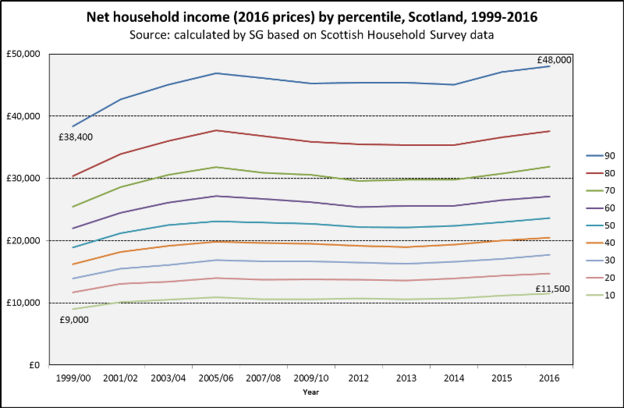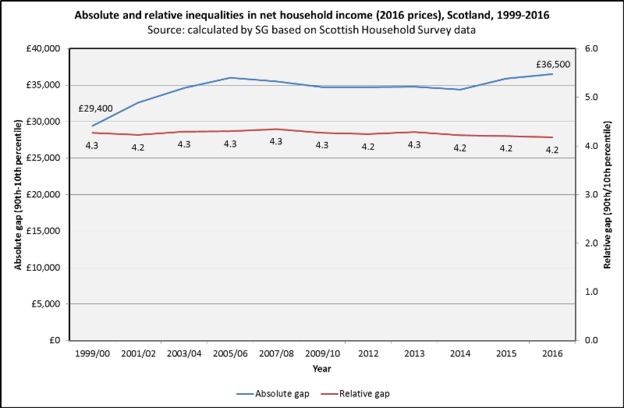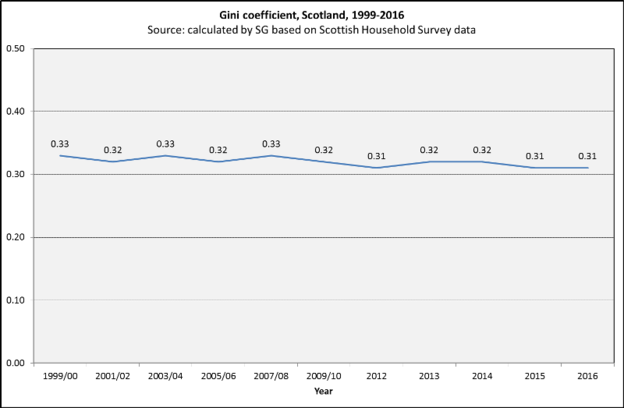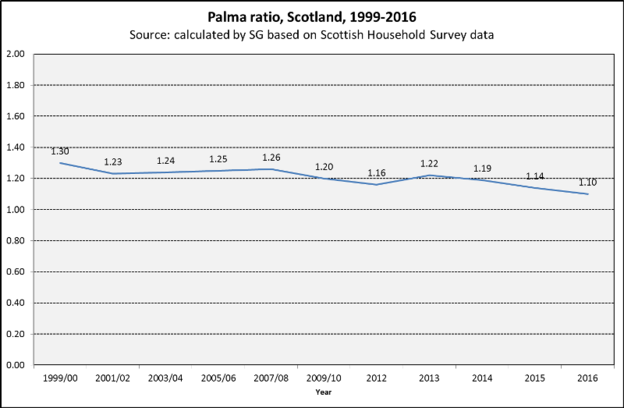Income inequality
Income inequality trends by percentile for Scotland click on graph to expand
click on graph to expand
The figure above shows trends in net household income, by percentile, in Scotland for the period 1999/2000 to 2016. There are several features of note: wide inequalities in income generally, with a particular gap evident between the 90th percentile and the rest; increases in income and widening inequality over time, followed by a fall in income levels across most groups around the time of the recession; and a later increase in income in the last part of the time period shown.
Trends in absolute and relative income inequalities for Scotland click on graph to expand
click on graph to expand
The trends in absolute and relative income inequalities (as defined by the difference between, and ratio of, 90th and 10th percentiles, respectively) are shown in the graph above. Despite some fluctuation, absolute inequalities in household income increased over time from a difference of £29,400 between the 10th and 90th percentiles in 1999/00, to £36,500 in 2016. Trends in relative inequalities were fairly flat, the income of the 90th percentile being consistently around four times those of the 10th percentile.
Trends in the Gini coefficient for Scotland
click on graph to expand
Different and more sophisticated measures of income inequality also suggest there has been little change in levels of inequality over the time period shown. The Gini coefficient measures the dispersion of the whole income distribution (rather than just comparing the extremes) and has a theoretical value ranging from 0 (representing complete equality) to 1 (representing complete inequality). For the data shown here, the Gini in Scotland has fluctuated over time between the values of 0.33 and 0.31.
Trends in the Palma coefficient for Scotland
Another statistical measure of inequality is shown above: the Palma ratio, which is calculated as the ratio of the richest 10% of the population’s share of income divided by the share of the poorest 40%. The figure above shows year by year fluctuation in this measure and overall the trend is fairly flat, albeit the value of the ratio did decrease in the last three years shown (from 1.22 in 2013 to 1.10 in 2016)
Note
We are aware that the data on this page are several years out of data. We hope to update these data later in 2023.
All data have been adjusted for inflation and are therefore shown in 2016 prices.
The graphs in this section have been derived from a GCPH report - Trends in earnings and income inequalities in Scotland and the UK 1997-2016.
Additional Resources
-
ResourceThursday, 26 May 2011
Your Better Life Index
A new, interactive index allowing users to measure and compare their lives. -
ResourceFriday, 25 March 2011
Monitoring Glasgow 1990
A report following Glasgow's year as European City of Culture, by John Myerscough -
ResourceWednesday, 22 December 2010
Economy & Labour Market Briefing
A review of economic and labour market data, with projections on what they mean for Glasgow. -
ResourceMonday, 26 April 2010
Economies of Life
An exploration of the principles of ecological and economical thinking and their relationship. -
ResourceMonday, 1 March 2010
Towards a Smarter Glasgow
A report which covers various aspects of the skills and educational performance of Glasgow, drawing conclusions on Glasgow’s performance in relation to the strategic objective of creating a Smarter Scotland. -
ResourceMonday, 1 February 2010
Towards a Wealthier & Fairer Glasgow
A report which examines the Purpose Targets set out in the National Performance Framework for Scotland, before a conclusion on Glasgow’s performance in relation to the strategic objective of creating a wealthier and fairer Scotland. -
ResourceSunday, 15 November 2009
A Step Change for Glasgow – Assessing Progress against Targets
Assessment of progress towards the targets laid out in 2006's A Step Change for Glasgow strategy. -
ResourceWednesday, 19 August 2009
A Games Legacy for Glasgow
Brochure outlining the potential legacy of Glasgow's role as Commonwealth Games host city in 2014. -
ResourceMonday, 3 April 2006
Let Glasgow Flourish
A comprehensive report on health and its determinants in Glasgow and West Central Scotland








